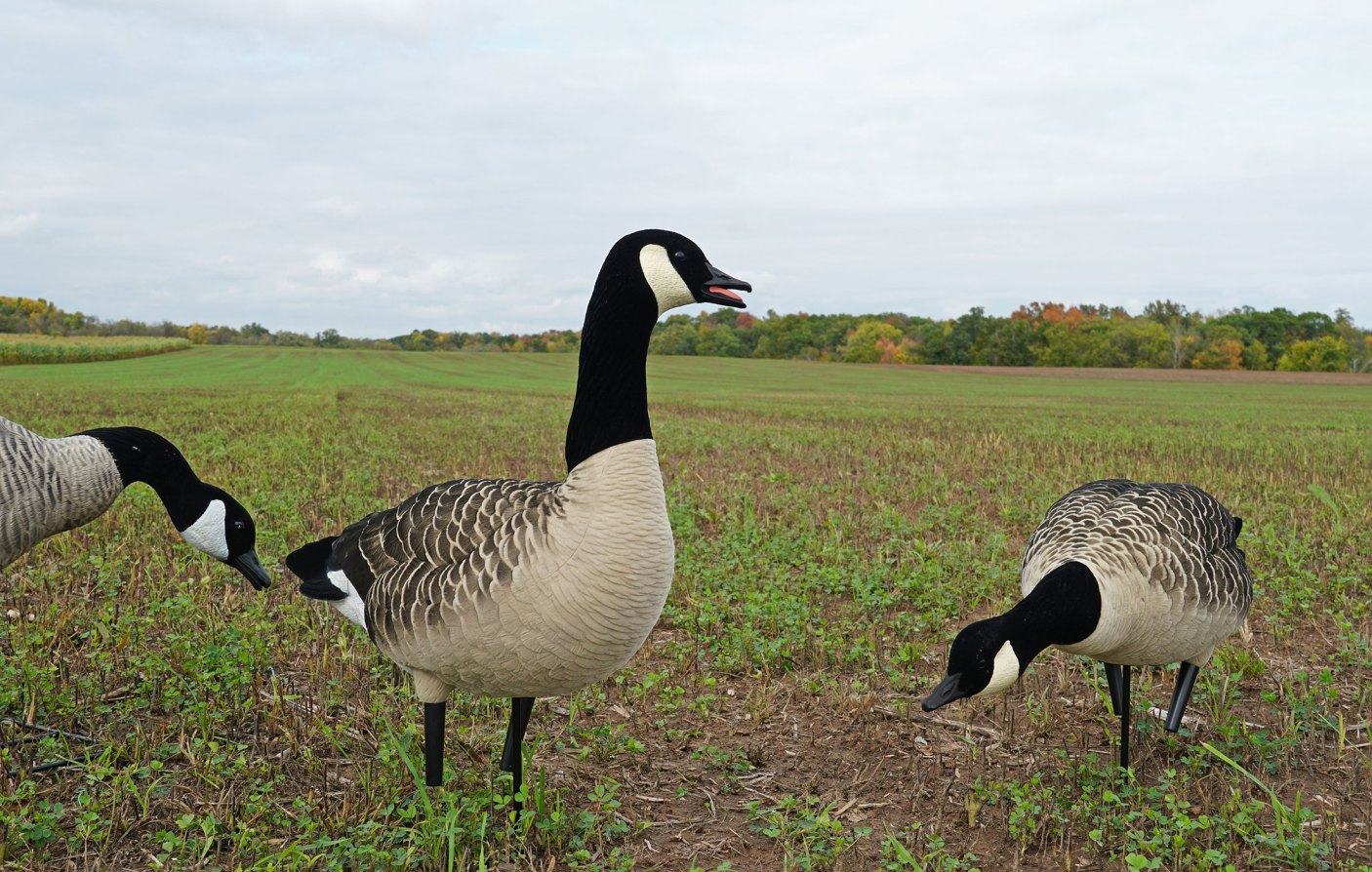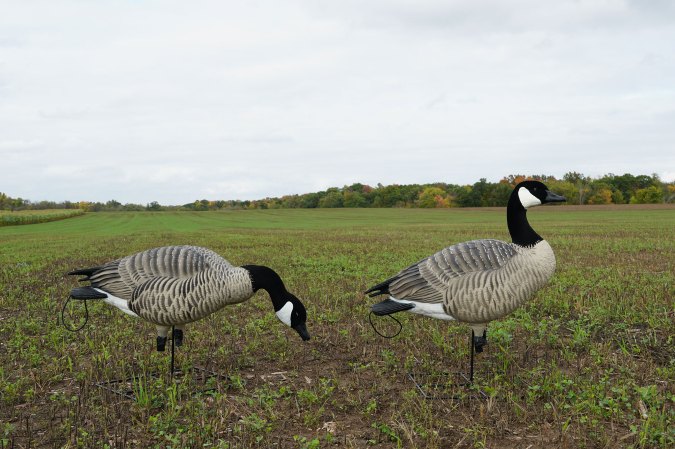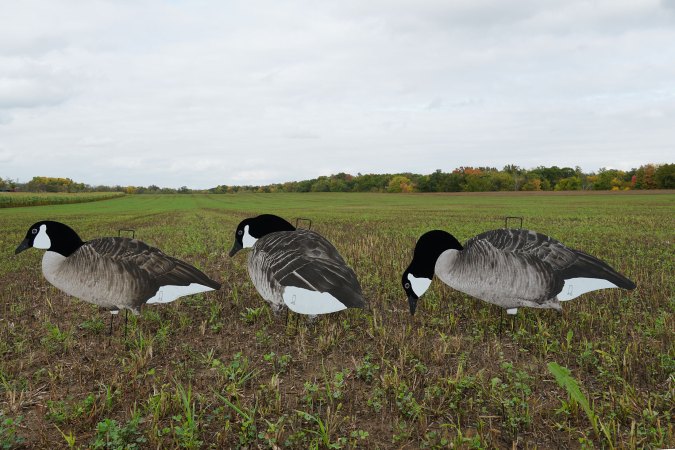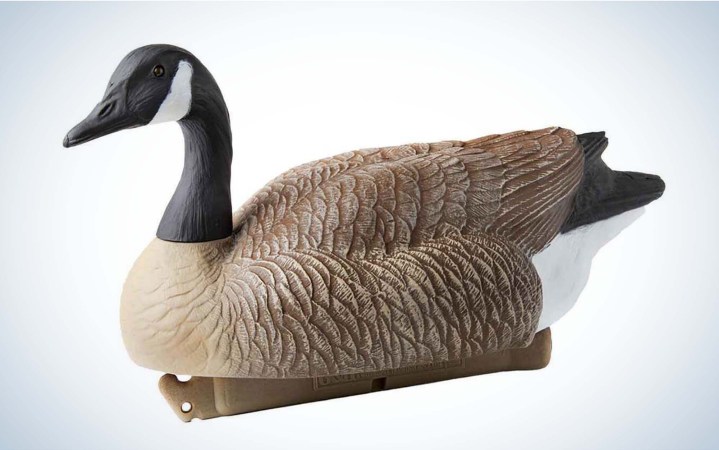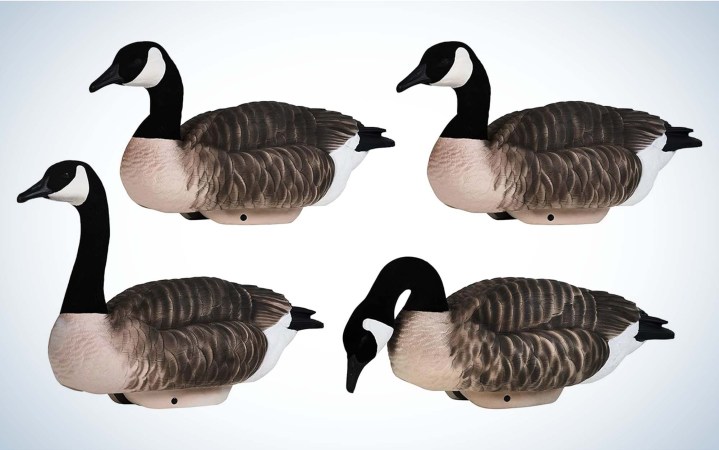We may earn revenue from the products available on this page and participate in affiliate programs. Learn More ›
It’s pretty easy to get obsessed with building a spread of the best goose decoys. Goose hunting is hard work and we’re all looking for any advantage we can get over the birds and competing hunters. So the idea of being able to buy your way to goose hunting success with a killer decoy spread sounds attractive.
The truth is that being a successful goose hunter takes a lot of scouting and deep knowledge of bird behavior. There are no shortcuts, not matter how much you spend. With that said, a realistic decoy spread sure can help put geese in shotgun range. Quality decoys will catch attention from a long distance, they won’t spook geese with glare, and they’ll hold up for many seasons of hard use. There are a ton of goose decoys on the market these days, and many of them are very good—some of them are junk. So to help you start your spread, or build up an existing spread, we’ve rounded up the best goose decoys for hunting fields and water.
Best Field Decoys
- Best Full-Body Overall: Avian-X AXF Lesser
- Best Full-Sized Full-Body: GHG XD Series
- Great Buy: Bigfoot B2
- Best Silhouette: Real-Geese Pro Series II
- Best Value Silhouette: Dive Bomb V2F
- GHG Pro Grade Silhouettes
Best Floater Decoys
- Best Floater: DSD Maxima
- Best for Big Geese: G&H Canada Goose Floater
- Best for Big Spreads: HeyDay Hydrofoam Canada
- Best Lesser: Avian-X Topflight Lessers
- Best Specklebelly: GHG Pro Series XD Specklebelly
How We Picked the Best Goose Decoys

As outdoor writers and editors we’ve been lucky to hunt geese all over the country utilizing a variety of setups and tactics. We’ve set countless spreads with guides, buddies, family members, and on our own. With that experience, we’ve been able to see what works and what doesn’t.
We used that experience to build the roster of decoys you’ll see here. We evaluated all decoys on realism, durability, ease of use and set up, and value.
Each decoy in our list has unique qualities that make it useful for specific scenarios. Decide how you’ll be hunting most often, nail down your budget, and then pick the decoys that will work best for you.
The Best Goose Field Decoys
Best Overall: Avian-X AXF Lessers
Key Features
- 8 Different body postures
- Sold with stakes
- Sold in a 12-pack
- Fully flocked
- Two-piece decoy design
- Includes bag
- Price: $665
- Price per decoy: $55
Pros
- Compact and portable
- Ultra-realistic
- Bag included
Cons
- Sold with stakes not bases, which can be a challenge in frozen ground
- Expensive
Don’t be fooled by their name, these “lesser” decoys work wonders on big geese too. I chase Canadas in Minnesota where we have mostly big honkers, but my buddies and I have had success running these lesser decoys (which are 20-percent larger than an actual Lesser Canada goose). I prefer lesser decoys because you can fit more of them into a smaller space, like the bed of your truck. Somehow, the 12-slot bag of lessers takes up about the same amount of space as a 6-slot bag of full-sized full bodies—even though the lessers don’t look much smaller in the field. See the photo below for a size comparison.

I could easily fit five dozen lessers into my pickup, which means I can hunt over a small full-body spread by myself if I wanted to. It also means that when we hunt as a group we don’t always have to mess around with enclosed trailers.
The decoys themselves are wonderfully lifelike. The variety of body postures keeps your spread looking realistic. In a decent wind the decoys turn to and fro adding motion, but their base design prevents them from spinning in circles in a stout wind. The flocking really does prevent glare on sunny days.
There are only two functional issues with these decoys. First, the stakes are tall and stout. So if you do a lot of late-season hunting on frozen ground, you’ll have to use a drill to get the stakes in. That can be a pain in the ass. Second, the body and head are two separate pieces. I haven’t had any issues with the heads popping off, but they’re definitely weaker than a one-piece decoy. You’ll have to take care of them, keep them out of the muck, and stash them in the bags to make them last. —A.R.
Best Full-Sized Full-Body: GHG XD Series
Key Features
- Lifelike and durable paint job
- Sold with square bases
- Sold in a four pack
- One-piece decoy design
- Decoys have tail loops for fast pick up
- Price: $170
- Price per decoy: $42.50
Pros
- Good motion in a breeze
- Realistic and large
- Durable
Cons
- Can be finicky to set up
- No bag included
The new XD series full-body decoys look like they’re fully flocked but they’re not. This is thanks to the “Durafeather” paint job which we also loved on the mallard version of the XD line (the GHG XD mallards won our editor’s choice in the best duck decoys review).
This is a large decoy that comes in two realistic body postures. The base system, which anyone who has run GHG field decoys will be familiar with, allows the decoy to turn and bob nicely in a breeze. However when setting the decoys we noticed that the upright version tended to tip back on its base. You have to press the stand fully into the body of the decoy until it clicks into place, which can be a pain when you’ve got dozens to set in the dark.
On a happier note, the decoys include tail loops for faster deployment and clean up. This helps prevent that new guy in the group from grabbing all the decoys together by their heads and rubbing down the flocking job. GHG sells these in a variety of three different four packs. You can go with the active pack, or feeder pack or the combo pack to build your spread however you like. —A.R.
Great Buy: Bigfoot B2
Key Features
- Leg-foot base is built into decoy
- Sold in a six pack or four pack
- 5 body positions
- Each decoy is three pieces
- Price: $220
- Price per decoy: $36
Pros
- Fast to set up
- Incredibly durable
- More affordable
Cons
- Bulky and hard to pack
- No motion
If you’ve got a trailer and want to build an affordable spread that will last forever, look no further than the Bigfoot B2s. You’ll need the trailer because these decoys are big and bulky. But they’re relatively affordable and they’ll last for many seasons of abuse.
Unlike other decoy designs, Bigfoot integrates the stand and base into the decoy (the decoys have big feet that they stand on, hence the name). This makes them easy to set very quickly. Simply put one down and go to the next one. However, it also means that they won’t move in a breeze. So if you’re the kind of hunter who cares about motion in the spread, these might not be for you.
The old-school Bigfoot design is no longer the most realistic looking full-body decoy on the market, but man, they still do kill a whole lot of geese every season. —A.R.
Best Silhouette: Real-Geese Pro Series II
Key Features
- Textured, non-reflective material
- Large wood stake
- 8 body positions
- Sold in 12-pack
- Price: $250
- Price per decoy: $20.83
Pros
- Most realistic silho decoy
- Unique body positions
- Large size
Cons
- Can be difficult to set in hard or frozen ground
- Pricey
- Limited availability
There are a lot of silhouette decoys on the market and most of them are very similar. Real-Geese decoys are different. They’re made from a heftier, textured, and non-reflective material. The decoy body is more flexible from a standard silhouette decoy. Plus, they’re bigger. The company says they’re about 15-percent larger than a 12-pound honker. To my eye, they are the most realistic looking silhouette goose decoy on the market.

Unlike other silhouette decoy designs which use thin metal stakes for anchoring into the ground, the Real-Geese decoys use large wooden stakes that weave into the body of the decoy. The downside of this design is that the stakes are difficult to press into hard or frozen ground. Real-Geese sells a stake puncher tool to solve for this. If you plan on hunting later in the season, I highly recommend including this tool with your purchase. The only other downside of these decoys is that they are often sold out. So buy them in big bunches when you can find them. —A.R.
Best Value Silhouette: Dive Bomb V2F
Key Features
- Flocked heads
- Steel stakes
- 4 body positions
- Sold in 12-pack
- Price: $90
- Price per decoy: $7.50
Pros
- Affordable
- Fast to set
- Flocked heads
Cons
- Not the most realistic looking
Dive Bomb Industries lowered the barrier to entry for field hunting geese with their affordable and practical decoys. You’ll see a lot of high school and college kids running Dive Bomb decoys because they are affordable and they’re easy to pack and transport (no trailer required). Dive Bomb sells their V2F in 12-packs and also a pack of five dozen for $425. That means you could buy a spread of 10-dozen silhouettes for $850. For a group of three of four goose hunting buddies, that’s pretty attainable—even if they’re broke college kids.
Importantly, the decoys do work. They are realistic enough to get the job done, and the flocking on the heads is a nice touch. I did notice some slight glare coming off the bodies of the Dive Bombs in bright sunlight, but it wasn’t bad. They are super fast to set and pick up. A dozen of them weighs only 6 pounds.
Dive Bomb also offers a fully flocked silhouette decoy (the V2FF), but that jacks up the price to $135 per dozen.
GHG Pro Grade Silhouettes
Key Features
- Flocked head
- Sold in 12-pack
- 6 body positions
- Price: $90
- Price per decoy: $7.50
Pros
- Light
- Easy to set up and transport
- Affordable
Cons
- Some glare in bright, direct sunlight
- Not the most realistic looking
GHG offers another good option in silhouette goose decoys. This decoy is very similar to the Divebomb V2F, with a flocked head and thin metal stake system. One small difference is that the GHG model has a larger handle for the stake so it’s easier to grab a whole bunch of decoys at once. This seems like a small detail but it actually makes a big difference when you’re trying to set hundreds of them quickly.
Also, the GHGs come in more body positions. If I was building a budget silhouette spread, I’d buy a few dozen of the GHGs and a few dozen of the Dive Bombs (they’re the same price) and mix them together to get the most diverse body postures and unique looking spread possible.
There are two downsides to these decoys. First I noticed a slight glare when they were in hot sunlight. Second, there was just a hit of reddish/pink on the white patches of some of my sample decoys. This was unnoticeable from a distance but hunters who are decoy stickers would be able to notice the unnatural tint at close range.
The Best Goose Floater Decoys
Best Overall: DSD Maxima
Key Features
- Flocked heads
- Oversized body for max visibility
- One-piece decoy
- Self-righting, weighted keel
- Four separate decoy line attachments
- Four pack (1 upright, 1 swimmer, 2 resters)
- Price: $250
- Price per decoy: $62.50
Pros
- Realism is unrivaled
- Over-sized decoy (27 inches long)
- Decoy will self-right
Cons
- They’re on the heavy side (four decoys weigh over 10 pounds)
- Most expensive on decoy of the review
The only full-body goose decoys that rival a Dave Smith Decoy are taxidermied goose decoys, called stuffers (skinned out birds that have their “hyde” affixed to a molded body). DSD’s Maxima is the company’s first foray into floaters, and they are every bit as realistic as the field offerings. Flocked heads that are almost identical to a live Canada lead into an oversized body with unparalleled feather detail. The body is slightly flexible so it doesn’t become as brittle (and crack) in extremely cold conditions. These decoys do cost more than any other on the market, but the DSD mantra is to buy fewer, more realistic floaters.
DSD introduced a new keel system with the release of the Maximas, called Swim-Bait. At the rear of the keel, there is a paddle that catches current to move the decoy in a more natural manner. It arches in the middle and then tapers to a point at the front of the decoy. There are four connection points (one at the rear and front, then two more in the middle of the keel). The rear and front tie-offs are for big current or high winds to keep the decoy from moving too much. Middle tie-offs promote more motion and are for low current and pond setups where Canadas are often facing in many different directions. You never have to worry about the Maximas capsizing. The keel is weighted so it will always self-right.
Best for Big Geese: G&H Canada Goose Floater
Key Features
- Molded, high impact plastic
- Treated surface for maximum paint adhesion
- Keel has front and rear tie off
- Keels weight and counter balance guarantees self-righting
- Hand-painted
- Removable swivel heads
- Six-pack (five head positions)
- Price: $210
- Price per decoy: $35
Pros
- High impact, molded plastic makes for a lighter decoy
- Raised feather detail and realistic acrylic eyes
- Keel weight always self-rights
Cons
- Removable heads may not be ideal for all hunters
G&H’s Canada Goose Floaters are at the top end of the price range for a plastic, non-flocked decoy. But they are also hand painted, made in the U.S., and come in six packs (many honker decoys are only available in four packs and can retail for $180). You’re paying for durability and 80 years of craftsmanship with a G&H. There are some fine decoys imported from overseas, but few will outlast a G&H floater, which is why you see veteran goose hunters hoarding as many of these as they can.
A no-shine paint job on the decoys make them look old without actually being old—kind of like buying a worn-in pair of ripped jeans on purpose. Except this has nothing to do with style or trends. The G&H mimics the look of a real honker on the water, unlike some decoys that are painted darker so they stand out at a distance but have little detail up close. The weighted keel ensures the goose will tip upright no matter how it lands in the marsh. Plus there are anchor points at the front and rear of the keel, a nice bonus that will make the spread look more natural (you don’t want every goose facing into the wind with a big spread). Removable heads allow you to position the birds in different ways, but if you’re picking up and throwing out decoys every day of the season, a one-piece floater may be more to your liking.
Best for Big Spreads: HeyDay Hydrofoam Canada
Key Features
- Hydrofoam construction (closed cell EVA resin)
- Hollow body reduces decoy weight
- Dual-keel design promotes natural movement
- Foam allows for a detailed body finish
- Easy-attach eye bolts located at front/rear of decoy
- Removable weights ensure the decoy self-rights
- Four-pack (2 active, 1 feeder, 1 sentry)
- Price: $215
- Price per decoy: $53.75
Pros
- Lighter than any plastic full-body Canada goose decoy
- Keel design allows it to be used on the water or in the field
- Hydrofoam is incredibly durable
Cons
- Decoy is 20 inches long, so it has a smaller footprint
Even with the upright weights inserted into the keel of the HeyDay Hydrofoam Canada (to ensure it self-rights on the water), the floater weighs just over 2 pounds. That’s less than some plastic ducks decoys. HeyDay was able to keep these decoys light by using a closed cell EVA resin that is similar to the material Crocs are made from. The design allowed HeyDay to hollow out the Canada floater, which keeps weight to a minimum. This is critical when you’re running a boat to the blind. It also makes the decoys incredibly durable. You can run over a Hydrofoam floater with your truck and it will survive. Plus the Hydrofoams won’t sink if you pepper them with shot.
The dual-keel helps steady the floaters on the water, but you can also place them on a river-bank or sandbar to add realism to the spread. You can do the same with a single-keel decoy, but it typically requires you to dig the decoy in so it won’t tip. Eye bolt attachments on the front and rear of the floater were my favorite feature. If you have big hands complimented by bratwurst-sized fingers, inserting decoy line clips into small holes drilled in a plastic keel can be a pain in the ass. HeyDay removes that difficulty with the oversized, heavy-duty eye bolts that are rated to hold 165 pounds. The feather detail in the Hydrofoams was on par with all of the decoys in this review—minus the DSDs, which no other decoy listed here could emulate. Each floater is painted based on aerial photos taken of live birds.
Best Lesser: Avian-X Topflight Lessers
Key Features
- Unmatched replication of an actual lesser Canada goose
- Weight-forward swim keel
- Four flocked swivel heads
- No-flake paint
- Rubberized body construction
- Sold in a four pack
- Price: $150
- Price per decoy: $37.50
Pros
- Johannsen’s replication of a lesser is one of a kind
- Decoy body is flexible/less likely to crack in the cold
- Flocked heads
Cons
- You’re likely going to lose a few detachable heads
Avian-X decoys are so realistic even veteran guides can mistake them for real geese on scouting missions. The Topflight lessers are true-to-size or slightly larger than a lesser Canada, and the feather detail on the body of the decoy is incredibly detailed. A flexible rubberized body ensures the floaters won’t crack in the freezing cold, which can happen if you’re throwing decoys around the deck of the boat in January. Detachable flocked heads complete the aesthetics of the Topflights, though it’s smart to buy a few extra heads in case they are lost in transit.
The keel is stout with connection points at the front and rear for decoy lines. Even the manufacturers of pricey decoys will sometimes skimp on the thickness of the keel’s plastic where it connects to the body, but the Avian-X keel will not bend and is unlikely to break. There is also more weight placed forward in the keel so the decoy will move in the slightest wind.
Best Specklebelly: GHG Pro Series XD Specklebelly
Key features
- One-piece decoy
- DuraFeather cuts glare and gives a feathery-soft look and feel
- IllusoryMotion color contrasts and shape positions display the ultimate illusion of movement
- 60/40 DuraKeel
- Active four pack (2 Resters and 2 Actives)
- Price: $200
- Price per decoy: $50
Pros
- Feather detail is on point
- One-piece decoy makes it more durable
- Oversized for added visibility
Cons
- It’s a heavy floater
- Plastic keel connection is thin/flexible
GHG’s Pro-Grade lineup has a reputation for being indestructible (as long as you don’t pepper one with too much shot), which is why many guides rely on these decoys. They cost more than many other models, but that investment is worth it because the decoys tend to last longer than the competition. The first thing you notice about the Pro-Grade specklebellies is the attention to detail. Not only is the feathering on the plastic body exquisite, GHG slightly raises one of the wings to replicate how one wing rests on top of the other when a live speck is sitting on the water.
Pro-Grade floaters are on the heavy side, but that also adds durability. Plus, they are one-piece decoys, so there’s no chance of losing removable heads. The keel has connection points at the front and rear, though the keel connection to the decoy body is a bit flimsy. However, that does allow the decoy to move a bit more, and it would take a significant amount of abuse to actually break the keel.
READ NEXT: Best Snow Goose Decoys
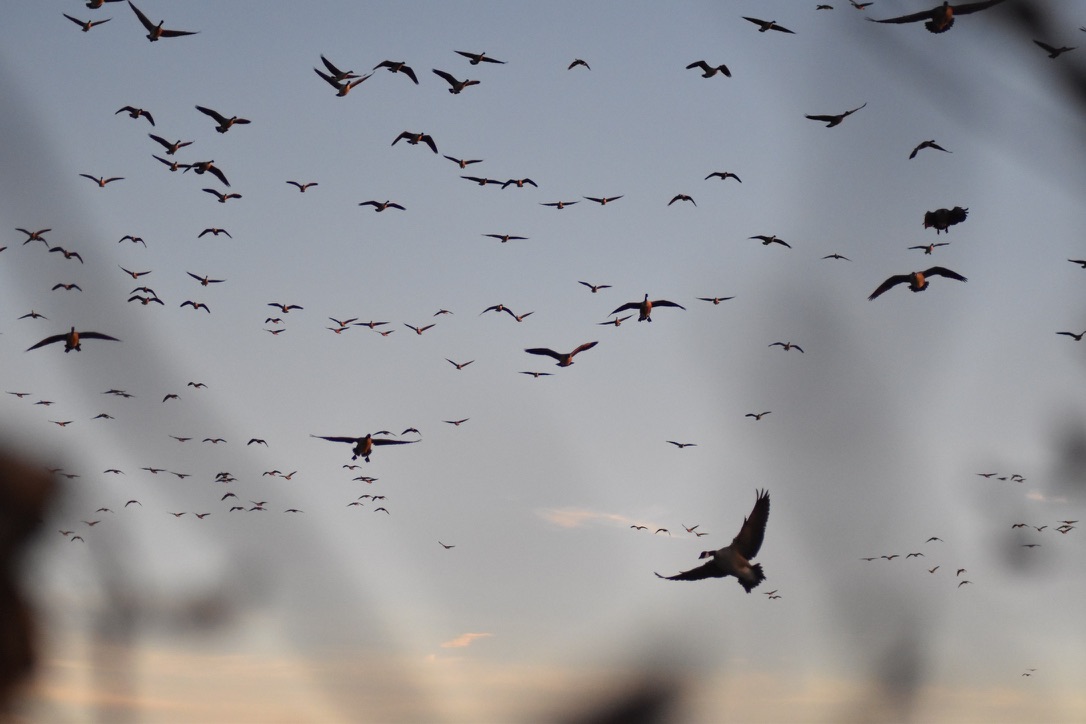
FAQs
In short, yes. However, setting a silhouette spread that “works” is an art form. You must understand where the geese are likely to come from, how they might circle, and where they’ll want to land. Then you’ve got to make sure that you angle your decoys appropriately. You want them at slightly different angles so that as geese circle your spread they see the broadside of at least some decoys. However you don’t want them all facing random directions, either. It takes time in the field to master this. I’ve found that silhouette decoys are most effective in the early season or while hunting a feed. In these scenarios geese are generally flying lower so they can better see the silhouette decoys. Trafficking in high-flying migrators is usually easier with a spread of full-body decoys.
Every decoy manufacturer champions the “realism” of their decoys. The quality of your full-bodies and floaters can make the difference between putting birds on the strap or never firing a shot. I know several core hunters that save up to buy as many premium decoys as they can because they believe decoys that look like real geese will kill more birds. Makes sense. But not everyone can afford five dozen DSDs. Of course, you can still fool wary honkers and specks with average fakes. You just need to make your spread looks intriguing to the geese. Use different brands of decoys and silhouettes. Be creative.
Absolutely. Mallards have no qualms with cupping into a mixed spread of ducks and geese. In fact, adding goose decoys to your duck hunting spread creates a bigger footprint which makes it more likely that birds will see it from a distance. Geese will certainly come to a mixed spread as well. When setting your spread, simply keep ducks in one area and geese in another. Hunters will often put duck decoys around the “kill hole” and place geese around the periphery. The best thing you can do is watch live ducks and geese feeding together in a field or on the water and then mimic that when you hunt.
Read Next: Best Duck Decoys
Final Thoughts on the Best Goose Decoys

Building a goose spread is expensive. So be thoughtful about your approach. Are you in it for the long haul? Are you willing to invest in a trailer and deal with the hassle that comes with one? Do you have lots of available storage space? If so, it makes sense to invest in quality full-body decoys. Even if that means buying only a dozen or two each year. Over time, you’ll have your dream spread. It also makes sense to go in on a spread with a trusted hunting buddy or two in order to split the cost and the storage space.
If you have a limited budget, limited storage space, and limited time to hunt, going with silhouette decoys is a good call. For $500 to $1,000 you can get in the game with a legit spread and you’ll be able to transport all the decoys in one vehicle and stash them easily in your garage.
If you mostly hunt over water or you’re a duck hunter who wants the opportunity to draw in bonus geese, well, then go with water decoys.
Regardless, consider your budget, available storage space, and hunting plans over the next few years before investing in the best goose decoys.
Best Field Decoys
- Best Full-Body Overall: Avian-X AXF Lesser
- Best Full-Sized Full-Body: GHG XD Series
- Great Buy: Bigfoot B2
- Best Silhouette: Real Geese Pro Series II
- Best Silhouette Value: Dive Bomb V2F
- GHG Pro Grade Silhouettes
Best Floater Decoys
- Best Floater: DSD Maxima
- Best for Big Geese: G&H Canada Goose Floater
- Best for Big Spreads: HeyDay Hydrofoam Canada
- Best Lesser: Avian-X Topflight Lessers
- Best Specklebelly: GHG Pro Series XD Specklebelly
